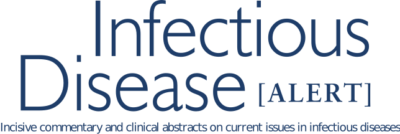
Infectious Disease Alert – October 1, 2004
October 1, 2004
View Issues
-
Azithromycin for Typhoid Fever
Five days of oral treatment with azithromycin appeared to be at least as effective as a similar duration of treatment of treatment with ceftriaxone in children in Cairo with typhoid fever. -
The Challenge of Right-Sided Endocarditis
Isolated pulmonic valve endocarditis is the topic of an interesting article from the Cleveland Department of Veterans Affairs Medical Center. Hamza and colleagues reported 3 of their own cases, involving men ages 47, 64, and 76, none of whom were intravenous drug addicts (IVDA). In 2 of the patients, Enterococcus faecalis was the causative pathogen, and in the other patient, a coagulase-negative staphylococcus was the pathogen. -
Resolution of Hepatitis C Infection
Hepatitis C infection is usually asymptomatic, but with insidious progression. This paper from Poland features the outcomes of a series of patients with acute hepatitis C in order to determine the resolution or progression of disease. -
Diagnosis of RSV Infection: Adults Are Not Just Large Children
The Binax NOW chromatographic assay was found to be the optimal method for detection of RSV in upper respiratory secretions of children, while DFA testing was optimal in adults. -
Chrysobacterium meningosepticum
Host factors are the major determinants of the outcomes of C. meningosepticum infections. Lin and colleagues describe 9 adults (40-82 years of age) and 2 children (0.5 and 1.5 years of age) seen at 2 hospitals in Taiwan from 2001 to 2002 with bacteremia due to Chrysobacterium meningosepticum. Six of the infections were community acquired. -
Candida glabrata
Caspofungin and flucytosine were the active antifungals against C. glabrata, while fluconazole was least active. Isolates with high level resistance to fluconazole demonstrated reduced susceptibility to voriconazole. -
Erythromycin and the Heart
Erythromycin use is associated with a 2-fold increased risk of sudden cardiac death and a 5-fold increase in those who concurrently receive other medications that significantly inhibit its metabolism by CYP3A4. -
Nitazoxanide Tablets for Giardiasis
Nitazoxanide (Alinia) is a broad spectrum antiparasitic agent, previously approved for use as an oral suspension for the treatment of cryptosporidiosis and giardiasis in children. It has now received FDA approval as a 500 tablet for the treatment of giardiasis in adolescents and adults. -
Rifaximin: Another Choice for Treatment of Travelers’ Diarrhea
Rifaximin (Xifaxan) has rreceived US FDA approval on May 25, 2004, for the treatment of travelers diarrhea caused by enteropathogenic (non-invasive) Eschericiha coli in individuals at least 12 years of age. Rifaximin is a rifamycin that is poorly absorbed (< 0.4%) from the gastrointestinal tract, and thus achieves very high concentrations in the feces. -
Updates
The High Cost of MRSA; Treatment of Latent TB: A High Priority; The APRICOT HCV/HIV Co-infection Study. -
Pharmacology Watch: Linking COX-2 Inhibitors and Cardiovascular Event Risk
Viagra: Maximum Capacity at High-Altitudes?; FDA Actions. -
Clinical Briefs in Primary Care supplement
